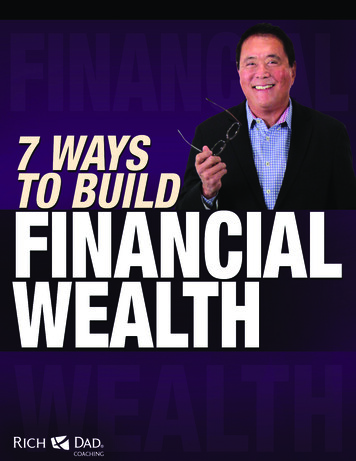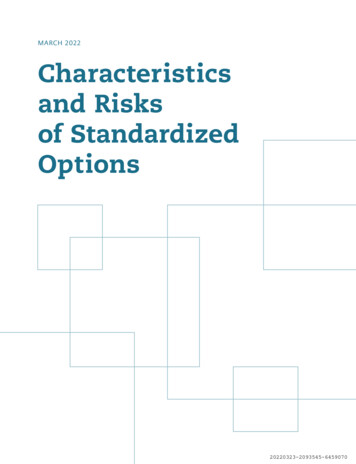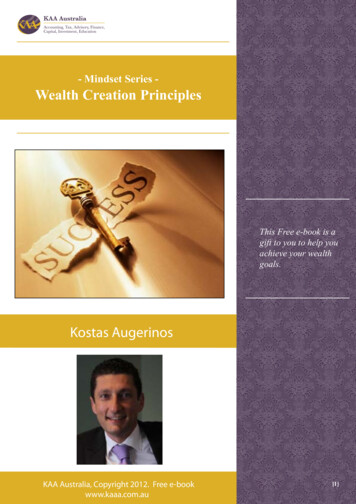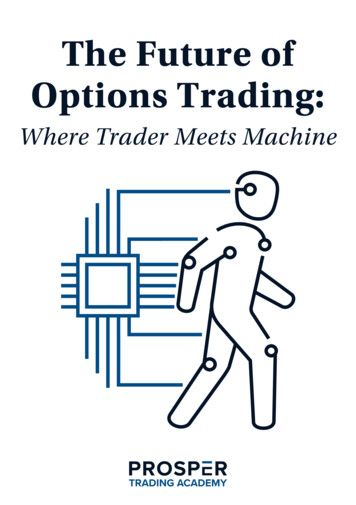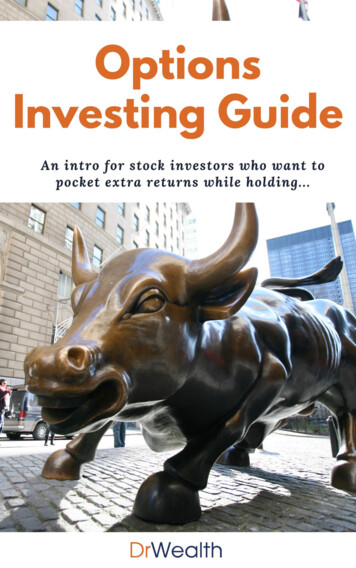
Transcription
Table ofContentsWhat are Options?Common terms in options tradingTwo types of OptionsCall OptionsPut OptionsExamples of how they workExtrinsic Value of OptionsWarren Buffett’s Options StrategyOptions Strategies for the Stock Investor1) Cash Secured Puts Strategy (aka Buffett’sOptions Strategy for Retail Investors)2) Wheel Option StrategyBonus: Option GreeksConclusionDisclaimer:All information in this book is purely for educational purposes. The Information in thisbook is not intended to be and does not constitute financial advice. It is general innature and not specific to you. You are responsible for your own investment researchand investment decisions. In no event will Dr Wealth be liable for any damages. Underno circumstances will the Dr Wealth be liable for any loss or damage caused by areader’s reliance on the Information in this report. Readers should seek the advice of aqualified and registered securities professional or do their own research and duediligence.
IntroductionYou might have heard of Options Trading, and how savvyinvestors use it to maximise their returns.This ebook aims to give you the basics of how this works withexamples, along with two beautifully simple Options strategies(inspired by Warren Buffett’s option strategy) that you can useto boost your investing returns.Warning:While Options can deliver extra profits, it can also result inunprecedented losses if you do not know what you are doing. Doyour own due diligence, manage your own risks and avoid usingit if you do not understand its mechanics well.
What are Options?An option is a contract between a buyer and a seller.It gives the buyer the right to buy (call options) orto sell (put options) the underlying assets at aspecific price on or before a certain date to the seller.Options are a powerful tool that can be used byinvestors as a hedge from market crashes, while alsogenerating recurring income.
Common Options Trading TermsBefore we proceed, here’re some terms you shouldknow. Strike Price: price at which a put or call optioncan be exercised.Expiry Date: date on which your option willexpire.Premium: current market price of the optioncontractCall Option: option that gives the buyerthe right to buyBuy Option: option that gives the buyerthe right to sellIn the Money (ITM): refers to an option thatpossesses intrinsic valueOut of the Money (OTM): refers to an optionthat only contains extrinsic valueAt the Money (ATM): when an option’s strikeprice is identical to the current market price ofthe underlying security
Two Types of OptionsAt its core, there are two types of options: Call andPut options. You can choose to either buy or sellthem.I’ll explain the four possible scenarios usingMicrosoft as an example. In this example, let’sassume that Microsoft is currently trading at 260.
How Call Options work (as aBuyer)A call option gives a buyer the right to buy 100shares of a stock at a specific price on or before anexpiration date from a seller.Here’s an example of how a call option works.Let’s assume that Microsoft is currently trading at 260. If I believe that its share price will goup within the next 2 months, I can buy a call optionexpiring two months for now.More specifically, I would buy a call option with60 days to expiry, at a strike price of 270 (theprice I believe Microsoft would hit). Doing so I wouldpay a premium of 430 for each contract (do notethat each contract represents 100 shares).60 days later If Microsoft remains below my strike price of 270,I will lose my premium. There is no point inconverting my options contracts to shares since I canget the shares from the stock market at a pricecheaper than 270.
However, if Microsoft share price were to shoot upbeyond 270 plus my premiums paid, my optionswould become profitable. I can exercise the optionsto convert them into shares.That said, most Options traders usually sell theiroptions for a profit, rather than converting them intoshares.Source: QuantinstiAs a buyer in this Call Options scenario, you areexposed to: Max loss 430 commission fees Breakeven point 270 4.30 274.30 Profit if Microsoft hits 280 ( 280- 270)X 100 shares – 430 premium 570Max profit Unlimited (assuming Microsoft’sprice has the ability to go to the moon )
How Call Options work (as aSeller)Selling a call option allows you to collect thepremium from the buyer.If it does not reach the intent strike price, the sellerwould be able to keep this premium. However, if thestock shoots up in value, the option seller would haveto sell its shares to the buyer at a loss. (If options areexercised.)Using the same scenario as above, here’s how itwould play out if you are the seller instead of thebuyer of call options. As a seller, you believethat Microsoft would not increase to 270 within the next two months so you are morethan willing to sell the call options.More specifically, you would sell a call option at astrike price of 270 with 60 days to expiry. Bydoing so, you collect 430 for each contract (notingthat each contract represents 100 shares).60 days later If Microsoft indeed stayed below 270, you wouldget to keep the premium given to you at the startsince it is unlikely the buyer would exercise it.
However, if Microsoft share price were to shoot upbeyond 270 plus premiums paid, your optionswould now be making a loss and the buyer couldchoose to buy your shares over at 270. Even if thecurrent price for Microsoft is 280.Source: QuantinstiAs a seller in this Call Options scenario, you areexposed to: Max loss Unlimited Breakeven point 270 4.30 274.30 Max profit 430 – commission feesThis is the main reason why you do not want to sellnaked call options. A jump in share price wouldresult in a huge loss!
How Put Options work (as aBuyer)A put option gives a buyer the right to sell 100shares of a stock at a specific price on or before anexpiration date from a seller.Now here’s an example of how a put option works,assuming once again that Microsoft is trading at 260.If I believe that Microsoft share price woulddrop in the next two months, I can choose to buy aput option expiring two months for now.More specifically, I would buy a put option with 60days to expiry, at a strike price of 250 (theprice I believe Microsoft would at least drop to).Doing so I would pay a premium of 655 for eachcontract (noting that each contract represents 100shares).60 days later If Microsoft remains above my strike price of 250,I will lose my premium. There is no point in sellingmy shares to the options seller, since I can sell themon the market for a price higher than 250.
However, if Microsoft share price were to dropbeyond 250 minus my premium paid, my optionswould become profitable. I can exercise them to sellmy shares at a higher price than what is trading onthe market.Note: most Options traders usually sell their optionsfor a profit rather than converting them into shares.Source: QuantinstiAs a buyer in this Put Options scenario, you areexposed to: Max loss 655 commission fees Breakeven point 250 – 6.55 S243.45 Profit if Microsoft drops to 240 ( 250 240) X 100 shares – 655 premium 345Max profit till Microsoft drops to 0, which isalmost impossible
How Put Options work (as aSeller)Selling a put option allows the seller to collect thepremium from the buyer.If it does not reach the intended strike price, theseller would be able to keep the premium. However,if the stock drops in value, the option seller wouldhave to buy shares from the options buyer at a loss.(If options are exercised.)Likewise, let’s use the same scenario as above, fromthe POV of the seller.As a seller, you believe that Microsoft would stayabove 250 within the next two months so you sellthe put option to the buyer above. More specifically,you sell a put option at a strike price of 250with 60 days to expiry. By doing so, you collected 655 for each contract (noting that each contractrepresents 100 shares).60 days later If Microsoft indeed stayed above 250, you wouldget to keep the premium given to you at the startsince it is unlikely the buyer would exercise it.
However, if Microsoft share price were to dropbelow 250 plus premium paid, your options wouldnow be making a loss and the buyer could choose tosell their shares to you at 250 per share. Even if thecurrent price for Microsoft is lower than 250.Source: QuantinstiAs a seller in this Put Options scenario, you areexposed to: Max loss till Microsoft drops to 0 Breakeven point 250 – 6.55 S243.45 Max profit 655 – commission feesSimilarly, you should not sell a naked put optionssudden drop in share price would result in a hugeloss.Sounds easy?
Well, the above is only one part of the optionspricing mechanism.It has only accounted for the intrinsic (inherent)value of the options while its extrinsic value hasbeen excluded.What is the “Extrinsic Value”of an Option?Well, extrinsic value is the difference between themarket price of the options and its intrinsic value.In other words, it is the ‘hope value’ – the hopethat the options would reach the strike price.This is determined by the time left till the optioncontact expires aka the ‘time value’ and its impliedvolatility aka the ‘degree of price swings’.
Time ValueUsually an options contract with a longer time framehas a higher premium due to the higher probabilitythat the strike price will be hit before expirations.As a contract nears its expiry date, it starts to lose itstime value as there is less time for the underlyingstock to move in the desired direction. Implied volatilityWhen the underlying stock has higher impliedvolatility, it means that its price fluctuatessubstantially. This poses a greater risk to optionssellers as stocks with higher implied volatility have ahigher probability of hitting the strike price.As such, stocks with higher implied volatility tendsto have a higher extrinsic value and are traded at ahigher premium.At the end of the day, as an option reaches its expiry,the extrinsic value would drop to 0, leaving only theintrinsic value of the option, aka its true price.
Warren Buffett’sOptions StrategyHow does Buffett use Options?Berkshire Hathaway uses a Put Selling strategy.They sell put options across 4 major indices: S&P 500 (US) FTSE 100 (UK) Euro Stoxx 50 (Europe) Nikkei 225 (Japan)Their Put options contracts typically have a long timehorizon of more than 15 years and the options areonly exercisable at expiry.
Bummer Such options contracts are not available to the retailinvestor.Let’s be clear. There’s no way we will be able to sell15-year puts like Berkshire Hathaway. Hence, theabove-mentioned strategy would not work for retailinvestors like us.Nonetheless, there is another way to use the samestrategy known as the Cash-Secured Puts strategywhich retail investors can access in the listed market.This strategy is also used by Warren Buffett and isuseful for investors who want to get paid whilewaiting to buy a stock at a predetermined price.By repeating this strategy, you can repeatedly makemoney from the regular premium and also have achance to buy your favourite stock at a discount. Nottoo shabby right?Here’s how it works:
Options Strategies for theStock Investor1 – Cash Secured Puts StrategyAka Buffett’s Options Strategy for Retail Investors.Selling cash-secured puts essentially means sellinga put option while ensuring you have the requiredcash to back it up, should the options getexercised.This is a useful strategy if you want to buyfundamentally good companies at a discount.Here’s a scenario to help illustrate how it works.Let’s say you have identified Nike as afundamentally good company with growingrevenue and a strong balance sheet.However, at the current price of 132, you think itis still expensive and you are only willing to buy ifit drops to 123 (7% decline).Instead of waiting and refreshing the charts everynight, you decide that it’s better to get paid whileyou wait.
Hence, you decide to sell a put option with a strikeprice of 123, preferably with a date to expiry of 30days since options decay much faster in the last 30days).By selling this put option, you will receive a premiumof 100 per contract.As we get nearer to the expiry date, if Nike staysabove 123, you get to keep the premium of 100.However, if Nike’s share price were to drop below 123, you would be able to purchase Nike stock at 122 ( 123 – 1 options premium received) which isa great discount as compared to the initial price.Win-win for you!Potential Risk of Cash Secured Put StrategyAs explained above, you’re going into a Cash SecuredPut option because you want to buy the stock at adiscount.This means that you may be assigned with the stockif prices drop below your strike price. Hence, youhave to ensure you have the required capital beforeusing this strategy.The main risk is when you try to do this withouthaving sufficient cash to back you up. That wouldefficiently become a naked put, which can bedangerous and lead to all the scary horror stories wehave heard about options and margin calls.
In our scenario above, for each contract, you need tohave at least 12,200 ( 122 X 100 shares) in youraccount ready to buy the Nike shares.With a premium of 100 and a buying power of 12,200, the monthly return is around 0.8%.Annualizing it, we would be getting around 9.8%,just to wait for a stock to drop to our ideal buy price.Your Mileage May VaryActual returns may vary depending on: the strike price you choose and, the volatility of the stockThe nearer your strike price is to the current stockprice, and the more volatile the stock, the higher thepremium you will get. But that also means there’s ahigher chance of the options getting executed.For the example above, the put option has a delta of0.21 which means it has a 21% chance of gettingexercised.
2 – Wheel Option StrategyThere are many ways to profit with options, and agood student must surpass his mentor.Instead of stopping at the cash-secured put strategy,let’s bring our options trading one notch higher withthe wheel option strategy.What is the Wheel Option Strategy?The Wheel Option Strategy is an options strategy ismade up of two parts:Selling cash-secured puts to collect the premium.This is done repeatedly till we are assigned with theshares of the underlying stocks.Sell covered calls to collect even more premium tillour shares get called.Rinse and repeat.
How to execute the Wheel Option Strategy1) Sell Cash Secured PutsThe first step is to sell a cash-secured put asmentioned above.Doing so, we will collect the premium from sellingthe put options. Using Nike as an example again, wewill collect 100 premium per contract, with a dateto expiry in 30 days.By the end of the month when the options expire,one of the two scenarios will happen.If Nike share price stays above 123, which has a79% probability base on its Delta, we just keep thepremium of the options and repeat by sellinganother put options to collect more premium.If Nike share price drops below 123, we will beassigned with Nike shares. Once you are assigned theNike shares, you will proceed to the next step.
2) Buy assigned sharesAs Nike share price drops to your strike price, youwould be assigned with its share using the cash youhave allocated previously.For each contract, you will receive 100 Nike shares at 123 per share. As such for 1 contract it would be 12,300.This is where the basic cash-secured put strategyends. But the subsequent steps would complete theloop to form the wheel strategy3) Sell Covered CallsAs a proud owner of 100 Nike shares, you can nowsell call options against your shares with a coveredcall option.In this example, we will sell a 30 date to expiry calloption with a delta of 0.40, meaning it has a 40%chance of being executed.At the current price, we will be able to collect 450per contract. By the end of the month, either of thesetwo scenarios would happen:
If Nike remains below the strike price, you willretain the share and can sell another covered calloptions for additional premiums. If Nike rises above your strike price, your Nikeshares will be called over and would be sold tothe options buyer, at your strike price.4) Sell your shareAs your shares get called away, you will receive thecash from the sale while also keeping the premiumyou had initially received.With your cash freed up, you can repeat the wholecycle again by selling a new cash-secured put.Your actual returns would vary depending on theunderlying stocks, the implied volatility, and theDelta at which you sold the options at.A safe estimate would be about 2% to 3% return amonth which would annualise to 24% to 36%.
Potential Risk of Wheel Option StrategyNonetheless, this strategy does come with risk.As with any stock, if the share price dips after youhave been assigned, you would be sitting with anunrealised loss.For this reason, this strategy should only be used onfundamentally strong stocks that are likely to rise invalue in the long run.For a start, look for companies that have strongeconomic moats and have a huge market cap.
Option GreeksAll in all, intrinsic and extrinsic factors can bemeasure by four indicators, collectively are known asthe “Options Greeks”.ThetaTheta measures the rate of time decay of an optioncontract.As time passes, options start to lose their value, thisdecay tends to accelerate as the options near expiryas the probability of hitting the strike price isreduced.By looking at the Theta of a particular optionscontract, we can determine the rate of this decay,which allows the seller and buyer to weigh the riskand reward of trading that contract.For example, an option contract with a Theta of -1.5is losing 1.50 in value each day.
DeltaDelta measures the change in option premiumas a result of the change in the prices of theunderlying securities.The Delta value can range from -1.00 to 0 for Putoptions and 0 to 1.00 for Call options.Put options have a negative relationship with theprice of the underlying asset thus their delta arenegative.Whereas Call options on the other hand, have apositive relationship with the price of the underlyingasset.If a call option has a Delta of 0.50, a 1 increase inthe price of the underlying asset will result in a 0.50 increase in the options price.Conversely, if a put option has a Delta of -0.50, a 1increase in the price of the underlying asset willresult in a 0.50 decrease in the options priceNote: In-the-money options (options at theirintended strike price) tend to have a higher delta ascompared to out of the money call options.Delta is also commonly used to determine theprobability of an option to expire in themoney. As such, a call option will a Delta of 0.25has roughly a 25% chance of being profitable.
GammaThe Delta of an option changes over time and this ismeasure by Gamma which measures the rate ofchange of Delta over time. (If you studiedphysics, Gamma is akin to acceleration while Delta isthe velocity).Unlike Delta, Gamma remains constant and thus isuseful to determine the stability of an optionprice.Gamma is at its highest when the option is at themoney. If an option has a Gamma value of 0.20, forevery 1 increase in the underlying stock, a calloption Delta would increase by 0.20 while a putoption Delta would decrease by 0.20.Another way to think of it is that, Delta measures theprobability of the options being in the money whileGamma measures the stability of this probabilityover time.
VegaVega measures an option’s sensitivity to impliedvolatility.We have mentioned how the volatility of theunderlying stock has a certain impact on the optionprice. Vega seeks to measure how much this pricewill increase or decrease, as a result of the change inthe implied volatility of a stock.In general, an option seller would benefit from a fallin implied volatility because, lower implied volatilitymeans a lower probability of hitting the strike price,which is what an option seller wants to achieve. Thereasoning is reversed for options buyers.
ConclusionIn this quick guide, we’ve covered the fundamentalsof Options trading and how stock investors can use itto pocket extra returns.I hope it’ll be a great starting point to help you makeyour money work harder for you, and to grow yourwealth faster.If you’d like examples of how real investors useoptions to boost their returns, join our live webinarsto learn directly from experienced investors who areactively using options in the live markets.Do remember that options are complex instruments,if you are still unsure of what you have just read, itmay be a better option (no pun intended) to read upmore before attempting to use options as aninvestment instrument!All the best!
AboutPowered by retail investors who believe thatinvesting can change lives. And pledges toprovide trusted financial education to individuals.LEARN MORE
Common Options Trading Terms Before we proceed, here're some terms you should know. Strike Price: price at which a put or call option can be exercised. Expiry Date: date on which your option will expire. Premium: current market price of the option contract Call Option: option that gives the buyer the right to buy Buy Option: option that gives the buyer

